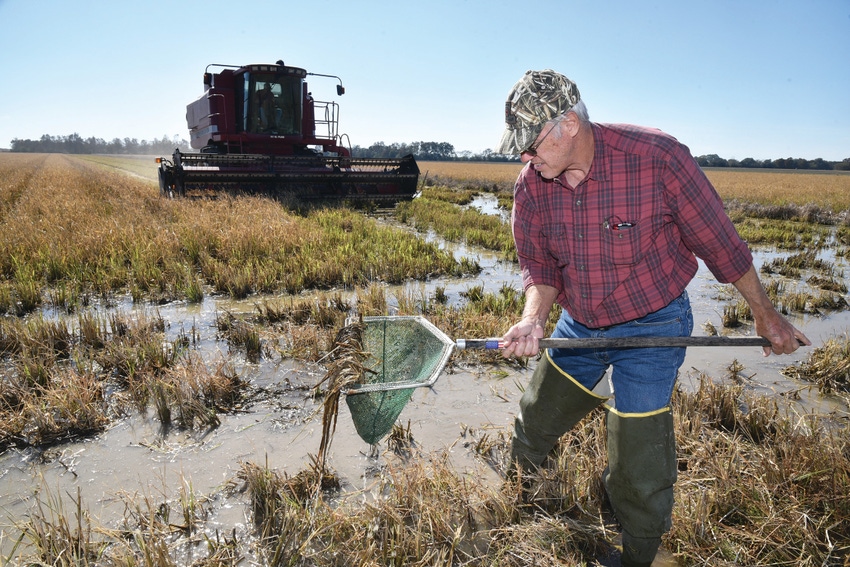
Where peak season would typically find crawfish enthusiasts and producers alike elbow deep in the sinus-melting satisfaction of a good boil, Louisiana’s shellfish farmers have instead encountered a serious situation. When traps set during the fall revealed either no crawfish at all or a measly one or two instead of a bounty, hopes for a high-quality season were put on hold.
“The current situation, in talking with a lot of farmers as well as the crawfish buyers, the overall average is about 10% of typical production,” said Mark Shirley, southwest area agent for Louisiana State University Extension. “That ranges from ponds that are catching zero crawfish to ponds that are catching up to 20 or 25% of normal. Across the board in all of Southwest Louisiana, the heart of the crawfish producing area, we're only about between 10 and 15% of what we should be producing.”
A typical crawfish harvest would begin in November in southwest Louisiana, where a small amount of harvest begins to set the tone for the coming season. In January, production would pick up as an H-2A labor force arrives to help facilitate the arduous process of setting, checking and re-rigging traps. Once the ball starts rolling, harvest escalates through the spring.
“Through December, January, and February, farmers will catch about one third of their total harvest in that time. And two thirds will come in the peak months of March, April and May,” Shirley said. “If it's a prediction based from what we caught in December, January and February, this year there is not going to be much of an increase in March, April or May.”
Pond tests
Shirley’s first clue a rough season was ahead, other than the high temperatures and lack of rain, came when he started checking test ponds in October. Where he would typically be able to find baby crawfish to determine a population, there were none. The trend continued, with some ponds producing no live young even through December, January and February.
“It wasn't until actually December 1, when we had a big rain event where we had three to four inches across Southwest Louisiana,” Shirley said. “That was the first big rain we had in many months. It actually soaked the ground and any crawfish that were still alive, were able to dig through their clay plug at the surface and come up with their babies.”
In a normal year, crawfish would be farmed from around 374,000 acres in Louisiana. This year, in addition to crawfish mortality, a portion of normal acres were excluded from production entirely.
“Of that 374,000, which is flooded now and trying to catch crawfish probably 50,000 acres could not be flooded due to a lack of water in canals and saltwater intrusion into the coastal parishes,” Shirley said. “In addition to that, the number of acres that probably will not produce any crawfish at all is another 50 to 80,000 acres that just don't have enough crawfish to justify putting traps and running traps.”
Uptick: Good news or timeless trend?
While headlines rejoice over lowering crawfish prices this spring compared to late winter, Shirley said the price decrease is the result of the typical trend of higher spring crawfish catches, not a sign of an increase in overall availability.
In December and January, crawfish buyers purchased only 3% of the crawfish they would sell in a normal year, leaving a market gap that potentially cannot be filled in 2024.
“It’s affecting everybody up and down the line. At all these little boiling places that open up in drive thru and you can get a few pounds of boiled crawfish right now think a three-pound order is somewhere around $22 to $25 for a three-pound order. And, it had been $45 to $50 just last month.” Shirley said. “That should be more like $12 or $13 for three pounds. Everybody's being affected.”
Crawfish availability is not solely an issue for Louisiana consumers. With significant statewide acreage decreases, a national shortage has put crawfish at the forefront of conversation throughout the South.
“At some of the distant markets I've talked to in Houston, Dallas, the Florida panhandle, Mobile, or Hattiesburg, Miss., trucks should be delivering several hundred sacks of crawfish in each of those communities,” Shirley said. “And instead the truck is going over there with maybe 10 or 12 sacks. So, they're trying to keep those markets where they can open up for a couple of hours or just a couple of days a week. But they definitely do not have enough to open up and have long lines. A lot of people are very short on supply.”
Cost is a very real concern for producers as well as consumers. In ponds where some or all of the crawfish population has been lost, farmers will need to purchase enough live crawfish to restock. With LSU’s recommended restocking rate hovering around 60-90 pounds per acre, restocking just doesn’t pencil out for producers.
“Everybody's concern is that there won't be a whole lot of crawfish available number one. Because of short supply, the live market is taking any and every crawfish that you catch,” Shirley said. “Typically, when the price of crawfish falls below $1, that’s when they'll buy crawfish and stock into those fields. This year, the price of crawfish may be three or four times that.”
Battling Biology
How did this happen? Louisiana is no stranger to drought conditions. Hot, dry summers are almost expected in the South. However, 2023’s abnormally hot and dry conditions set the stage for a crawfish crop failure.
“The real culprit is the fact that we just had extreme drought during the summer and fall,” Shirley said. “The 2023 precipitation record for Southwest Louisiana was 43.61 inches and the average is 57.2.”
Crawfish burrow down into the levees at the end of the season, with standing water at the base of the burrow to provide the humidity needed for their young and seal themselves in with a several inch thick clay plug. This year, lack of late season rains meant the plugs at the top of the burrows were not as thick as usual. Additionally, the severity of the drought led to ground cracking, causing many burrows to dry out – effectively killing all the crawfish inside.“Temperatures are running much hotter than normal, in addition to the lack of rainfall, and that combination just results in mortality of the majority of our crawfish in the ground,” Shirley said.
Read more about:
CrawfishAbout the Author(s)
You May Also Like






